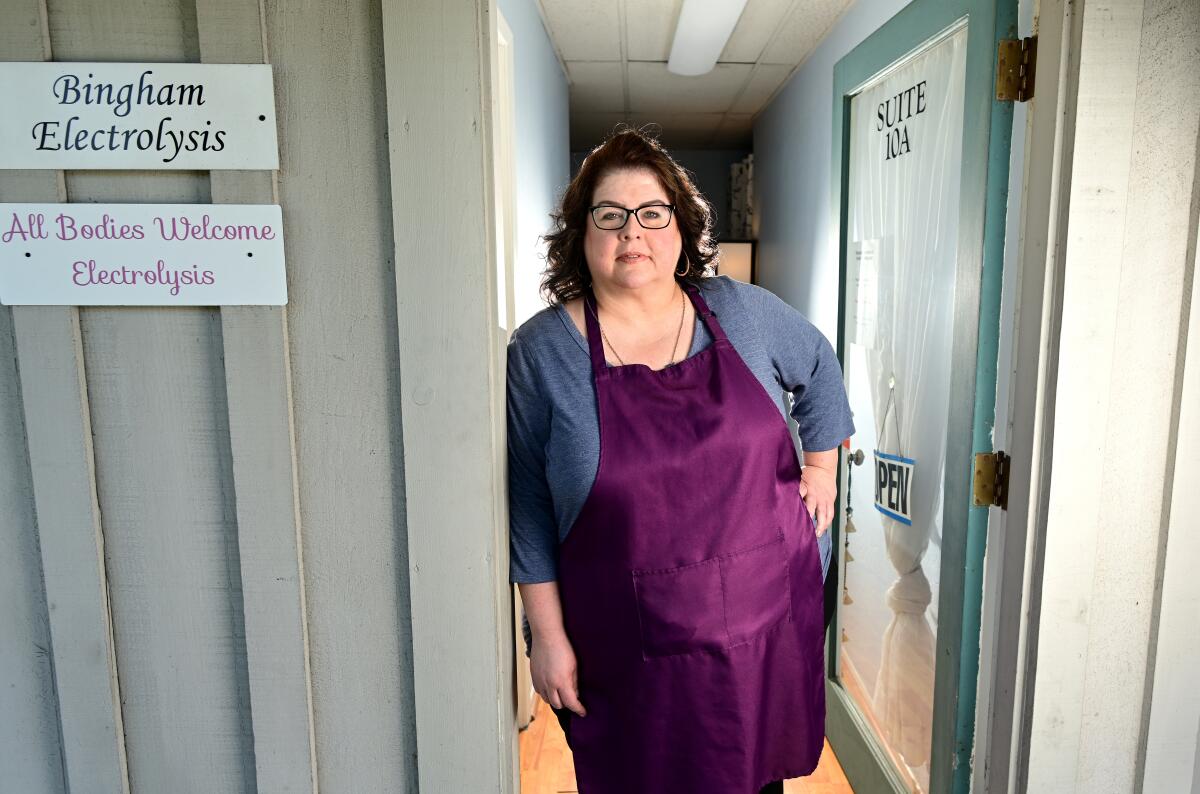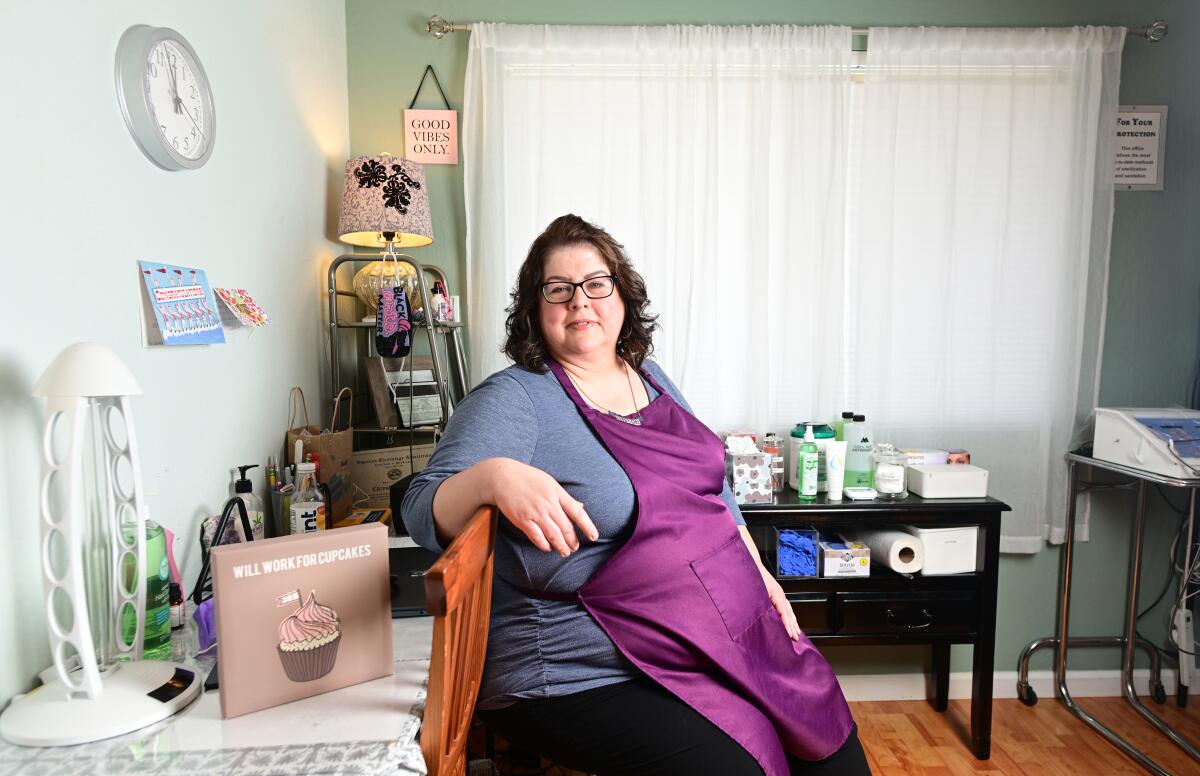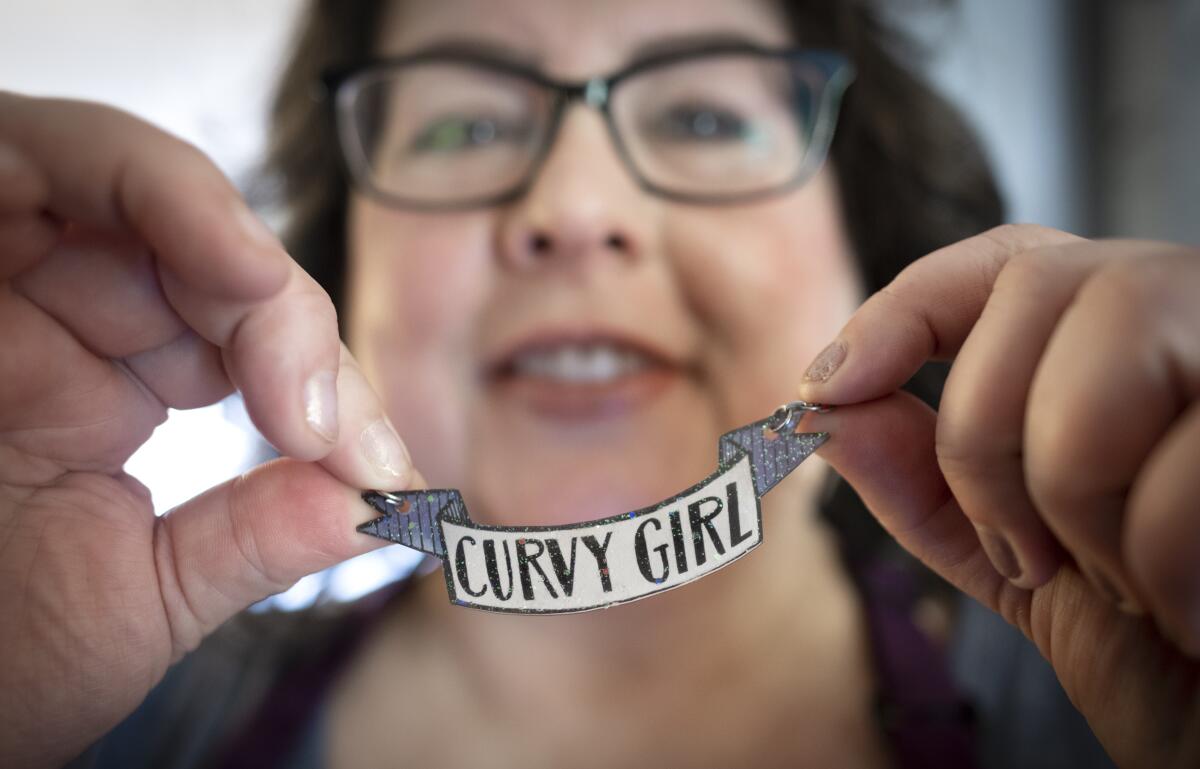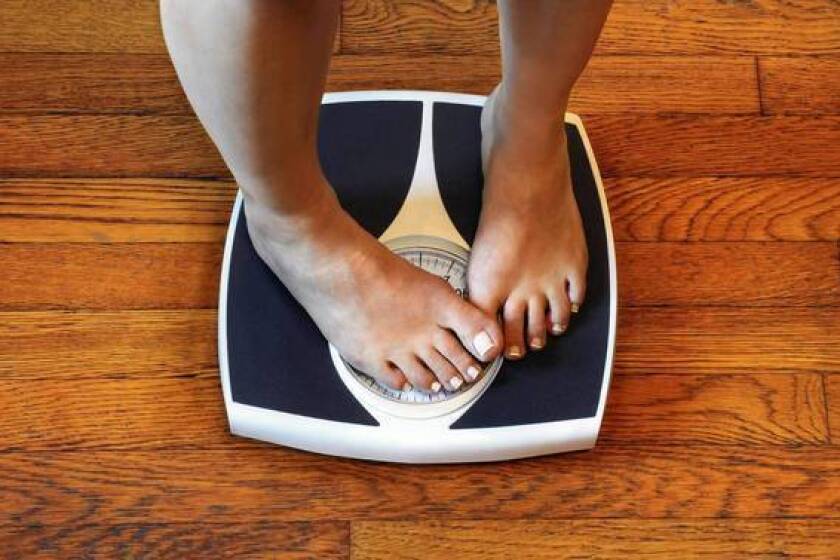Fat shaming, BMI and alienation: COVID-19 brought new stigma to large-sized people

- Share via
Chrystal Bougon cried after the needle went into her arm. Not because her first dose of the Moderna vaccine hurt. But because, finally, being fat actually paid off.
The 53-year-old was inoculated in the parking lot of Kaiser Permanente in San José on a rainy Friday in March, four days after eligibility in California was broadened to include people with underlying conditions. Among them, a body mass index of 40 or more — 233 pounds for an adult who is 5 feet 4 inches tall.
Bougon’s medical record at Kaiser shows she is morbidly obese; as an activist, she prefers the word “fat.” Her experience with medical providers has been one incident of size stigma after another, she said, like the time she went in with a scratched cornea and was told to lose weight. She fears being hospitalized with COVID-19 and unable to advocate for herself.
“For that reason I decided, you know what, I’m not going to feel guilty about [being vaccinated]. I’m going to do it,” she said. “And I’m not going to apologize for it. I’ve been in fear the whole flipping time, staying home, avoiding everybody. I couldn’t do my job. I’m an electrologist. I remove facial hair. I couldn’t come to work. I couldn’t make money.”

That, however, is changing, thanks to a vial of vaccine, a very sharp needle and a policy switch that allowed women and men like Bougon a chance to be inoculated before the general public — in California, about a month early.
“It’s not every day that we get something for free because we’re fat,” said Bougon, who launched a YouTube channel called Fat Product Review.
For more than a year, the COVID-19 pandemic has accentuated yawning inequities in American life, disparities in race and ethnicity, poverty and privilege. Black and Latino communities have been among the hardest-hit, with death rates alarmingly higher than among white people.
The virus has underscored yet another serious inequity. Studies link higher body mass index, or BMI, with increased risk for severe COVID-19, including higher rates of hospitalization. Other research shows weight bias can keep larger-bodied people from seeking and receiving appropriate care.
At the same time, the pandemic has highlighted a clash between the medical establishment and the fat acceptance movement, between those who use clinical terms such as “obesity” and “overweight” and those who proudly describe themselves as “large-bodied,” “people of size,” “fat,” and even “super fat.”

In 2013, the American Medical Assn. recognized obesity as a disease. The fat acceptance movement argues it is possible to be healthy at any size.
The debate is playing out in doctors’ offices and hospital emergency rooms with renewed intensity and raising a complicated question.
With more than 70% of adults in the United States either overweight or obese, according to the Centers for Disease Control and Prevention, who are we first?
People or patients?
::
Weight stigma by healthcare providers has been documented for decades.
In 1969, researchers found that physicians had negative views of people with obesity and that they preferred not to treat them. A 1982 survey of doctors found that the only people held in lower esteem than those with high BMI were people with drug addiction, alcoholism and mental illness.
Not much has improved.
In a 2020 article in the journal Metabolism Clinical and Experimental, the authors noted that weight bias is still widespread among healthcare providers and that the higher a person’s body mass index, the more negatively that person will be viewed.
“The implications of weight stigma are particularly alarming in the context of COVID-19,” they wrote. “Individuals with obesity are especially likely to delay care, or avoid it completely, because of bias and humiliation experienced in healthcare settings.”
Dr. Fatima Cody Stanford, an obesity medicine physician who teaches at Harvard Medical School, is one of the paper’s three authors. The pandemic, she said in an interview, has “compounded and magnified weight bias and stigma” in the United States “in addition to the other inequities we see.”
But after that, Stanford parts company with the fat acceptance movement. She does not use the word “fat,” instead preferring “people with obesity.” She recognizes obesity as a disease and points to research that shows it as a risk factor for the coronavirus.
“Obesity is characterized by chronic inflammation,” she said. That condition “is now interacting with an acute inflammatory process, SARS-CoV-2. ... The acute inflammation of a cytokines storm does not interact well with a chronic inflammation from obesity.”
Cytokines are a protein that the immune system uses to fight disease. In some COVID patients, the immune system floods the body with cytokines, which attack blood vessels and fill lungs with fluid.
Obesity has been linked with severe COVID-19 outcomes since early in the pandemic. Research published in March in the CDC’s Morbidity and Mortality Weekly Report found COVID patients with obesity are more likely to be hospitalized, spend time in the intensive care unit, be put on a ventilator and die.
The Centers for Disease Control and Prevention said people who are merely overweight, not just the obese, may be at high risk of a serious case of COVID-19.
“I would hope that people in the health-at-every-size movement embrace the science,” Stanford said, “and learn about the pathophysiology of obesity as a disease.”
But activists in the fat acceptance movement dispute such research, arguing that the weight bias people with an elevated BMI endure in medical settings also shows up in medical studies. They note that BMI was never meant as a yardstick for individual health but, rather, as a means of measuring populations. And they point to sections of the studies themselves as ammunition.
The March study published by the CDC lists five limitations, among them: “Hospitalization risk estimates might have been affected by bias introduced by hospital admission factors other than COVID-19 severity, such as a health care professional’s anticipation of future severity.”
In other words, said Ragen Chastain, who is the author of “Fat: The Owner’s Manual” and has written widely on weight bias in medical research, “If fat bodies experience something more than thin bodies, fat bodies are to blame, rather than the unequal treatment fat people receive due to weight stigma.”
::
On a Tuesday afternoon in early April, Tigress Osborn kicked off the National Assn. to Advance Fat Acceptance’s first webinar of 2021. And she wasted no time getting to the point.
Tell me, she said, about when you first became aware of the coronavirus and when you started thinking about what it meant to you as a fat person.
Osborn is just the second Black person to head NAAFA in the group’s 52-year history. The organization was founded by a straight white man angry about how his large-bodied Jewish wife was treated because of her size.
In the years that followed, Osborn said in an interview, “NAAFA has been predominantly white, but also predominantly interested in treating fatness with sort of a white neutrality.” The organization ignored questions of race and ethnicity, even though a high BMI is more prevalent in Black and Latino communities, according to the CDC.
Osborn took the helm in January, as she was recovering from COVID-19. She and the NAAFA board are focused on “creating a more inclusive fat community.” They also are addressing the impact of COVID-19 on people of size.
The webinar tackled “Diet Culture and Fat Shaming in the Age of the Coronavirus,” and there was way too much to talk about — including the embrace of a three-letter word most of the world still views as a slur.
“I started to think almost immediately about what it would look like for me as a fat Black person,” said panelist Da’Shaun L. Harrison, whose exploration of race and weight, “The Belly of the Beast: The Politics of Anti-Fatness as Anti-Blackness,” will be published in August.
“I know how the medical industry engages people who look like me,” Harrison said, “who show up with bodies like mine, with skin like mine, right?”
Harrison knew because of a lifetime of interactions with doctors who looked at the body before them and wanted to treat weight instead of asthma or gastrointestinal distress, who celebrated Harrison’s weight loss as a child instead of addressing the illness that caused it.
“Especially as a kid, it was very damaging for me,” Harrison said. “It set a precedent for me that it didn’t matter how good I did or did not feel in my body. What mattered was if I was thin.”
The 24-year-old showed up in an ambulance at an Atlanta emergency room in the heart of the pandemic: a fat, black nonbinary person who uses the pronouns “they” and “them,” with a cough and chest pains, who hadn’t slept and had trouble breathing.
Harrison had just been lifted out of the ambulance. They were lying on a stretcher in the early morning darkness, terrified they had COVID-19 and could die, fearful of what would happen to them once inside the hospital walls. A male nurse walked up.
“Wow, you’re so big,” he said to Harrison by way of introduction. “The first thing we need to do is get this weight off you.”
::
About 10 weeks after the first Californian died from COVID-19, the state Department of Public Health posted on its website a new 36-page policy called “California SARS-CoV-2 Pandemic: Health Care Surge Crisis Care Guidelines.”
The first version of the policy recommended that scarce resources be used for “saving the most life-years” and that “patients who do not have serious comorbid illness are given priority over those who have illnesses that limit their life expectancy.”
Advocates for large-bodied people, people with disabilities and elderly people immediately pushed back. The fear, said Sondra Solovay, was that individuals in these marginalized communities would be “completely left out of lifesaving care in the care-rationing situations.”
Solovay is a pioneer in fat activism and the law, although she stopped working after becoming disabled. She founded the Fat Legal Advocacy Rights & Education project (FLARE), one of the groups that fought the crisis care guidelines.
The final version of the guidelines, posted in June, is threaded through with anti-discrimination language. The key comes on Page 5 of the 38-page document:
“Healthcare decisions, including allocation of scarce resources, cannot be based on age, race, disability (including weight-related disabilities and chronic medical conditions), gender, sexual orientation, gender identity, ethnicity (including national origin and language spoken), ability to pay, weight/size, socioeconomic status, insurance status, perceived self-worth, perceived quality of life, immigration status, incarceration status, homelessness, or past or future use of resources.”
Brandie Sendziak, FLARE’s legal director, points out another effect of size discrimination.
“When you discriminate based on people’s weight and size,” Sendziak said, “you’re disproportionately affecting people of color.”
Marcy Cruz knows this firsthand. She is 50 and lives in Queens, N.Y., with her 72-year-old mother, an immunocompromised cancer survivor. She weighs more than 300 pounds, is a plus-size fit model, a freelance writer, and a Latina who has limited insurance coverage.
She put off being vaccinated because she was terrified of leaving the apartment. She has not taken public transportation in more than a year. Ride-share services are too expensive. She does not drive.
No matter what she has gone to the doctor for, she said, her physician would prescribe the same thing: weight loss. She fears being diagnosed with COVID-19 and having to go to a hospital.
“Are they going to give me the same treatment as a skinny person — or even a white person?” Cruz asks. “Will they have things that accommodate me? A larger robe? Seats without arms? Will the bed be comfortable? These are the things we have to think about as larger people.”
The things, she said, that feel like a “punishment for being fat.”
More to Read
Sign up for Essential California
The most important California stories and recommendations in your inbox every morning.
You may occasionally receive promotional content from the Los Angeles Times.












